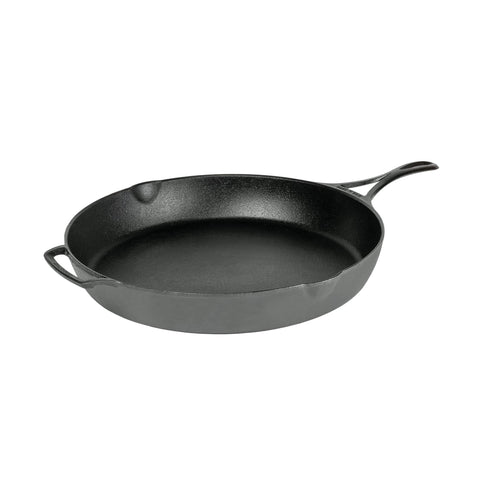How to Season Cast Iron Without An Oven
by Jannika Resido

Seasoning is a crucial step that enhances the performance and lifespan of your cast iron pan.
Seasoning a cast iron pan without an oven is a straightforward process that involves cleaning, choosing the right oil, stovetop seasoning, and regular maintenance.
By following these simple steps, you'll not only achieve a well-seasoned pan but also enhance its non-stick properties and prolong its lifespan.
Seasoned cast iron pans become more non-stick with each use, providing a cooking experience that gets better over time.
So, whether you're searing, frying, or baking, a well-seasoned cast iron pan is your key to achieving exceptional results. If you're still new to cast iron pans, try watching our guide on how to choose a cast iron pan!
TRY: Read our buyer's guide on cast iron pans and check out our cast iron cookware collection!
Step-by-step guide to season cast iron pans without oven
Seasoning a cast iron pan without an oven is a breeze with a few simple steps. This alternative method will let you achieve a well-seasoned pan that will enhance its durability and cooking performance.
Whether you are new to cast iron care or seeking an oven-free approach, these practical tips will keep your cast iron in top condition for delicious and hassle-free cooking.
Clean your cast iron pan
To season your cast iron pan properly, begin by cleaning it thoroughly with warm, soapy water to eliminate any residue. Once cleaned, ensure the pan is completely dry before advancing to the seasoning process.
This crucial preparation sets the foundation for achieving a well-seasoned cast iron pan that enhances its non-stick properties and longevity.Choose the right oil and apply a thin and even layer
Selecting the right oil is very important for an effective cast iron pan seasoning.
Choose a high smoke point oil such as vegetable oil, canola oil, or flaxseed oil.
After choosing the right oil for your pan, apply a thin, even layer on your chosen oil across the entire surface. This ensures a successful seasoning process.
The high smoke point prevents the oil from breaking down during the stovetop seasoning, facilitating the creation of a durable and non-stick layer on your cast iron pan.
Use a stove top
We usually follow 4 steps on seasoning cast iron pan using a stove top:- Heat the pan first, place the oiled pan on a burner over medium heat.
- Allow the oil to heat until it begins to smoke slightly.
- Once smoking, reduce the heat to a minimum to maintain the smoking point.
- Let the pan heat for 15-20 minutes, allowing the oil to penetrate the cast iron.
Cool and wipe excess oil
After the stovetop seasoning process, it's better to cool the cast iron pan naturally. Allow the pan to reach room temperature on its own to ensure the integrity of the seasoned layer.
Once cooled, use a paper towel to gently wipe off any excess oil. This step helps in achieving a balanced and even seasoning on the cast iron surface, preventing any residual oil from affecting the pan's cooking performance and maintaining its non-stick properties.Repeat as needed
To enhance the longevity and cooking performance of your cast iron pan, it's essential to repeat the stovetop seasoning process.
This involves building up layers of seasoning for optimal results. By regularly repeating this maintenance step, you ensure that your pan maintains its non-stick surface over time. This simple but effective practice will keep your cast iron pan in top condition, ready to deliver excellent cooking results with each use.
How to properly store your seasoned cast iron pan
After seasoning your cast iron pan, proper storage is one of the most important factors in maintaining the seasoning of your cast iron pan.
After each use, ensure it's thoroughly dry before putting it away. To prevent moisture-related issues, store your pan in a cool, dry place.
Consider placing a paper towel between stacked pans to avoid scratching. If stacking isn't an option, use soft liners or cloths to cushion each pan.
Lastly, avoid storing food in the pan to prevent odours and potential degradation of the seasoning. With these tips, your seasoned cast iron pan will be ready for reliable and effective use whenever you need it.

About the author
Jannika Resido is Sous Chef's online content specialist. She is an expert in southeast Asian food and ingredients! Jannika has several years of experience writing blogs and features for online publications. She loves savoury dishes, trying new ingredients (especially the fruity ones!) and discovering recipes from across the world.




